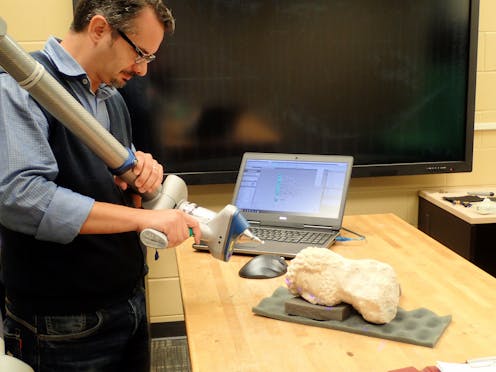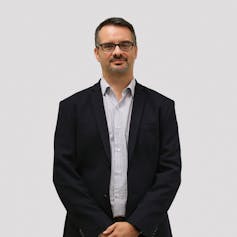A digital archaeologist helps inaccessible collections be seen
Davide Tanasi, a digital archaeologist, thinks it's a pity when historical artifacts are locked away in storage. He's working to fix this by sharing them as 3D models.


The Abstract features interesting research and the people behind it.
Davide Tanasi is a digital archaeologist at the University of South Florida. He creates highly detailed 3D scans of archaeological artifacts that can be viewed online or used to create 3D printed replicas.
Why is it important to digitize these artifacts as 3D objects?
It helps spread knowledge about them and guarantees that they will be passed to future generations. For example, the USF Libraries Farid Karam M.D. Lebanon Antiquities Collection is one of the largest collection of Lebanese archaeological artifacts in the U.S. Some of the objects are 3,500 years old. Due to space and personnel restrictions, it was never exhibited and made fully available to the general public. Being unpublished, hardly accessible and poorly visible online, it basically does not exist. Our project to recreate the collection in 3D is called the Virtual Karam Project. It allows us to share those objects around the world, hopefully triggering interest to curate and display the collection.

How do you scan them?
The 3D models of archaeological artifacts must be geometrically accurate to satisfy interested scholars but also realistic enough to engage the public. The “body” of the artifacts is captured with an ultra-precision 3D scanner integrated into a measuring robotic arm. The multicolored “skin” is acquired via a set of high quality digital photographs. From the combination of the two features comes the actual 3D model.
How common is it for museums to create 3D images of their collections?
The fire which recently destroyed the National Museum of Brazil was a global wake up call for curators to start plans for the 3D digitization of historical and archaeological collections. Plans not just for simple archiving and dissemination purposes but also to create a sister digital collection, which can be 3D printed and function as a “surrogate” in case the originals are destroyed. With the British Museum and the Smithsonian Institution leading the charge, it is becoming more common even for small museums to start virtualization projects for their collections.
What other kinds of collections are you digitizing in this way?
I’m working on the Joseph Veach Noble Collection at the Tampa Museum of Art, a group of 150 artifacts, mostly high quality Greek black and red-figure pottery from Athens, Attica and South Italy. Another one of my projects involves the Luigi Palma di Cesnola Collection of Cypriot Antiquities, which includes exquisite examples of ancient pottery and statues ranging between 2,500 B.C. to 400 A.D. Both collections are largely unpublished, only partly accessible to the local public, with poor digital representation.
How do you hope people will use these digital collections?
They are an advanced archival record for the museum. But the 3D models can also be built in Virtual Reality and Augmented Reality experiences for the public. Digital replicas can also be used by scholars in every part of the world or to popularize archaeology or trigger interest towards a certain museum or site. Digital collections can also be integrated in the teaching curriculum at K-12 and university level for history, art history and anthropology.
[ Like what you’ve read? Want more? Sign up for The Conversation’s daily newsletter. ]
Davide Tanasi does not work for, consult, own shares in or receive funding from any company or organization that would benefit from this article, and has disclosed no relevant affiliations beyond their academic appointment.
Read These Next
The celibate, dancing Shakers were once seen as a threat to society – 250 years later, they’re part
‘The Testament of Ann Lee,’ Mona Fastvold’s 2025 film, depicts part of the long history of Shaker…
As DOJ begins to release Epstein files, his many victims deserve more attention than the powerful me
Powerful men connected to Jeffrey Epstein are named, dissected and speculated about. The survivors,…
The world risks forgetting one of humanity’s greatest triumphs as polio nears global eradication − 7
Polio may finally be defeated in the next 5 years. Will the world recognize what an extraordinary achievement…






